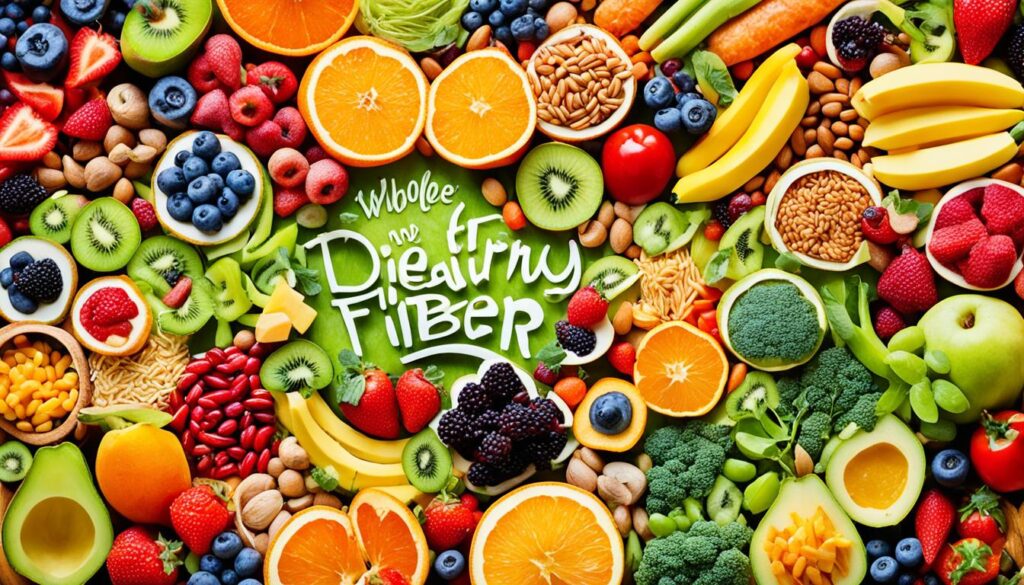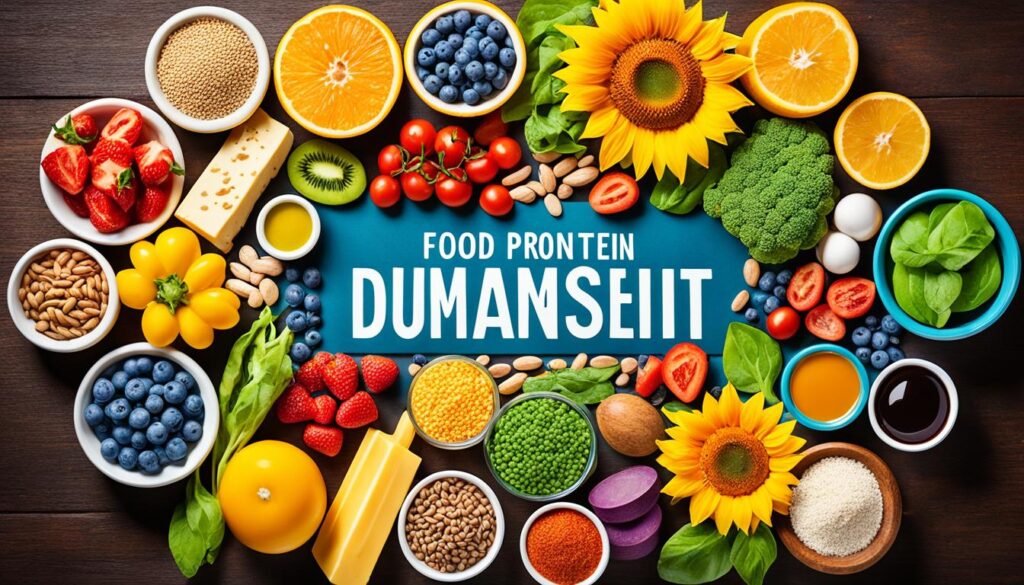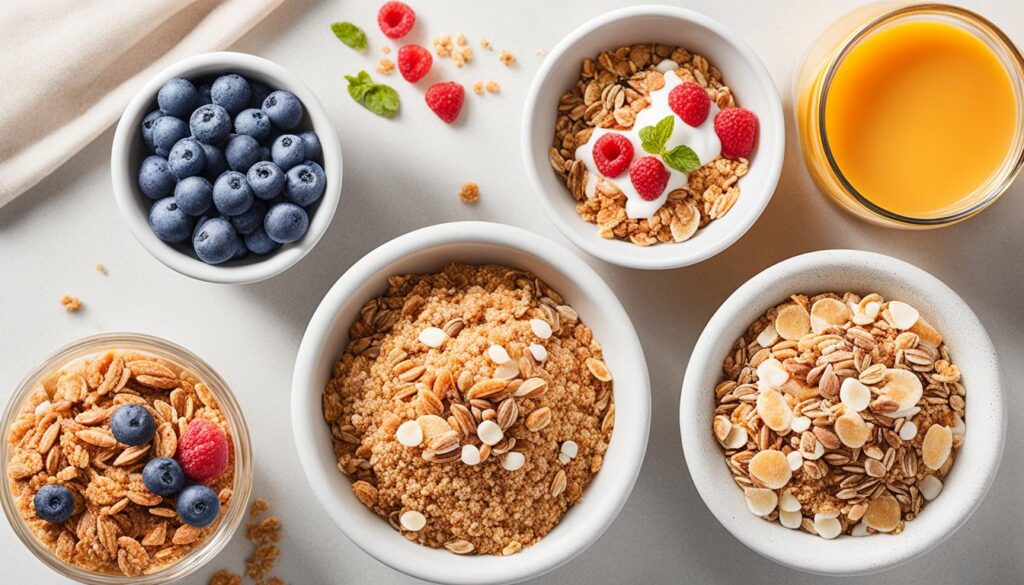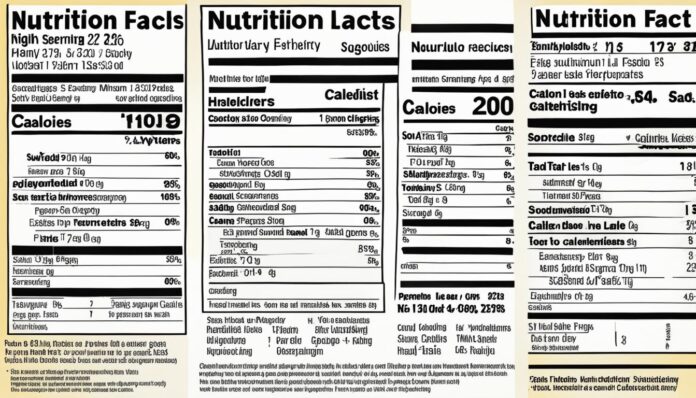Have you ever stared at a food label, wondering how to navigate the maze of information to make the best choices for your health? Nutrition labels can be a powerful tool, but only if you know how to decipher them. In this comprehensive guide, we’ll explore the ins and outs of reading nutrition labels, empowering you to make informed decisions that align with your dietary needs and wellness goals.
Key Takeaways
- Nutrition labels provide crucial information about a food’s nutrient content, including serving size, calories, and key nutrients to limit or increase.
- Monitoring calorie intake and comparing serving sizes to actual consumption is essential for managing weight1.
- Food labels highlight nutrients that may contribute to chronic diseases, such as saturated fats, trans fats, cholesterol, and sodium1.
- Certain nutrients like dietary fiber, vitamin D, calcium, and potassium are vital for good health and should be emphasized1.
- The %DV on food labels helps consumers determine the nutrient content of a food item based on a daily 2,000-calorie diet1.
Understanding the Nutrition Facts Label
The Nutrition Facts label is a valuable tool for making informed and healthy food choices2. This label, first mandated under the Nutrition Labeling and Education Act of 1990, has undergone recent updates in 2016 to better reflect consumer eating habits2. By understanding the key components of the Nutrition Facts label, individuals can navigate the grocery aisles with greater awareness and discernment.
Components of the Label
The Nutrition Facts label provides a wealth of information, including the serving size, calories, and various nutrient amounts3. It’s essential to pay close attention to the serving size, as this reflects the typical amount consumed per serving2. The number of servings per container is also crucial, as it indicates how many portions are in the package.
Serving Size and Servings Per Container
The serving size and servings per container are vital components of the Nutrition Facts label2. Serving sizes have been updated to better reflect realistic consumer consumption patterns, making it easier to understand the nutritional information2. The number of servings per container provides context for the overall nutritional content of the product, enabling consumers to make informed decisions about their portion sizes.
| Nutrition Fact | Description |
|---|---|
| Serving Size | The amount of the food typically consumed per serving2. |
| Servings Per Container | The number of servings in the entire package or container2. |
By understanding the serving size and servings per container, consumers can accurately assess the nutritional content of the food they’re purchasing and make healthier choices that align with their dietary needs.
“Deciphering the Nutrition Facts label is crucial for making informed decisions about the foods we consume. It empowers us to take control of our health and well-being.”
Calories and Energy Balance
The calorie content on the Nutrition Facts label represents the amount of energy provided by a single serving of the food4. Maintaining a healthy energy balance by matching calorie intake with calorie needs is important for weight management5.
Calories are often prominently displayed at the top of nutrition labels, indicating the energy content of a serving4. Monitoring calorie intake is essential for weight management, whether trying to maintain, gain, or lose weight5. Tracking the serving size helps in adjusting nutrient amounts accordingly if consuming more or less than the specified serving size5.
| Nutrient | Importance |
|---|---|
| Carbohydrates | The body’s main source of energy, categorized as simple or complex on food labels4. |
| Fats | Categorized into saturated, unsaturated, and trans fats on nutrition labels4. Total fat content is listed to help consumers understand the different types of fats present5. |
| Proteins | Essential for tissue repair, boosting the immune system, and maintaining energy levels4. |
| Vitamins and Minerals | Crucial for metabolism, immune system function, and overall health. Vitamin and mineral percentages on labels are essential, aiming for higher values of important nutrients45. |
Maintaining a balanced energy balance by aligning calorie intake with calorie needs is crucial for weight management and overall health5. Monitoring the calorie and nutrient content on nutrition labels can help individuals make informed choices and achieve their dietary goals.
“Understanding the basics of nutrition labels and how to interpret them is the first step towards making healthier choices.”
Nutrients to Limit
The Nutrition Facts label highlights several key nutrients that should be limited in one’s diet, as excessive consumption can contribute to adverse health outcomes. These include saturated fat, trans fat, and added sugars6. Proper monitoring and moderation of these nutrients is essential for maintaining a healthy, balanced diet.
Saturated Fat, Trans Fat, and Added Sugars
Saturated fat, often found in fatty meats, dairy products, and certain oils, can raise levels of LDL (bad) cholesterol and increase the risk of heart disease6. Similarly, trans fats, typically found in processed and fried foods, have been shown to have detrimental effects on cardiovascular health6. Added sugars, which are distinct from natural sugars found in fruits and vegetables, can contribute to weight gain, type 2 diabetes, and other metabolic issues6.
The Nutrition Facts label provides valuable information to help consumers make informed choices about these nutrients. According to the label, a typical 100g serving of a food product may contain 0.3g of saturated fat, 45.5g of carbohydrates, and 3.8g of sugar6. However, the recommended daily intakes for adults are 20g of saturated fat, 260g of carbohydrates, and no more than 30g of free sugars6. Paying attention to these values can assist individuals in maintaining a healthy, balanced diet.
Sodium and Its Health Impacts
Another nutrient that should be limited is sodium. Excessive sodium intake, often found in processed, canned, and restaurant foods, is associated with an increased risk of high blood pressure, stroke, and other cardiovascular issues6. The Nutrition Facts label indicates that a typical 100g serving may contain 1.0g of salt, while the recommended daily intake for adults is 6g of salt6. Monitoring and reducing sodium consumption is crucial for maintaining good health.
By understanding the importance of limiting these key nutrients and utilizing the information provided on the Nutrition Facts label, consumers can make more informed and healthier choices for themselves and their families.
Nutrients to Increase
While the Nutrition Facts label highlights nutrients that should be limited, it also identifies essential nutrients that should be increased in our diets. Consuming adequate amounts of dietary fiber, vitamins, and minerals can provide a range of health benefits, from improved digestion to better immune function. By understanding the importance of these “nutrients to increase,” we can make more informed choices to support our overall well-being.
Dietary Fiber and Its Benefits
Dietary fiber is a crucial nutrient that plays a vital role in maintaining a healthy digestive system. Nearly 80% of U.S. adults use the Nutrition Facts panel on food labels to inform their buying decisions7, and increasing their fiber intake is a key consideration. Dietary fiber helps to promote regular bowel movements, reduce the risk of constipation, and may even lower the risk of certain chronic diseases, such as heart disease and type 2 diabetes7. The recommended daily fiber intake is between 25 to 35 grams per day, as indicated on the Nutrition Facts label8.
Essential Vitamins and Minerals
In addition to dietary fiber, the Nutrition Facts label also highlights the importance of essential vitamins and minerals. These micronutrients are crucial for a wide range of bodily functions, from supporting bone health to boosting the immune system. Consuming a nutrient-dense diet rich in fruits, vegetables, whole grains, and lean proteins can help ensure you’re meeting your daily needs for these essential vitamins and minerals. Food label use is positively correlated with healthier dietary intake in adults7, making it a valuable tool for identifying nutrient-rich options.

By understanding the importance of the “nutrients to increase” highlighted on the Nutrition Facts label, you can make more informed choices to support your overall health and well-being. Incorporating a balance of dietary fiber, vitamins, and minerals into your diet can have a profound impact on your digestive function, immune system, and long-term health789.
Deciphering the Percent Daily Value (%DV)
The Percent Daily Value (%DV) on the Nutrition Facts label is a valuable tool for understanding how much of a particular nutrient a single serving of a food item contributes to your overall daily intake. This percentage can help consumers quickly identify if a food is high or low in a specific nutrient and make informed comparisons between products10.
General Guide to %DV
As a general rule of thumb, a food item that contains 5% DV or less of a nutrient per serving is considered low, while 20% DV or more per serving is deemed high10. Protein, however, generally has no Percent Daily Value (%DV) listed on the label, and the same is true for trans fat and total sugars10. The footnote on the Nutrition Facts label states that 2,000 calories a day is used for general nutrition advice10.
When interpreting the %DV, the general rule of thumb is to aim for less than 5% for nutrients you want to limit, such as sodium and saturated fat, and aim for 20% or more for nutrients you want to increase in your diet, like fiber, vitamin D, calcium, and iron11. This guidance can help you make healthier choices and ensure you’re meeting your daily nutrient requirements.
The Nutrition Facts Label also emphasizes the need to consume key nutrients in moderation, such as fats, sodium, and added sugars12. By understanding the %DV, you can make more informed decisions about the foods you consume and work towards a balanced, nutrient-rich diet101112.
How to Read Nutrition Labels: A Guide to Making Healthier Choices
Navigating the wealth of information on a nutrition label can seem daunting, but mastering this skill is crucial for making informed and personalized food choices. By learning how to effectively read and interpret the Nutrition Facts panel, consumers can align their dietary habits with their unique health and wellness goals13. This comprehensive guide will walk you through the key components of the nutrition label, empowering you to become a savvier shopper and take control of your nutrition.
The Nutrition Facts label provides a wealth of details about the nutritional content of a food item, including calories, macronutrients (carbohydrates, protein, and fat), and essential vitamins and minerals14. Understanding how to read and apply this information can help you make healthier choices that support your overall well-being.
- Familiarize yourself with the serving size and servings per container. This information is crucial for understanding the actual nutrient content of the product14.
- Pay close attention to the calorie count and consider how it aligns with your daily energy needs. Consuming too many calories, regardless of the nutrient profile, can lead to weight gain13.
- Identify nutrients to limit, such as saturated fat, trans fat, sodium, and added sugars, and aim to choose options that are lower in these components13.
- Seek out foods that are higher in beneficial nutrients like dietary fiber, vitamins, and minerals, as these support overall health and well-being13.
- Utilize the Percent Daily Value (%DV) to gauge the relative contribution of each nutrient to your daily intake. As a general rule, 5% DV or less is considered low, while 20% DV or more is high1415.
By applying these strategies and making nutrition label reading a habit, you can empower yourself to make healthier food choices that are tailored to your personal dietary needs and preferences13. Embracing the information on the Nutrition Facts panel is a powerful step towards achieving your health and wellness goals.
“Mastering the art of reading nutrition labels is the key to unlocking a world of personalized, healthy eating.”
Remember, the nutrition label is a valuable tool that can guide you toward making informed decisions about the foods you consume. By understanding its components and applying the strategies outlined in this guide, you can navigate the grocery aisles with confidence and take control of your nutrition label reading, healthy food choices, and personalized nutrition.
Comparing Food Products Using %DV
The Percent Daily Value (%DV) on nutrition labels is a powerful tool for consumers to compare the nutrient content of different food products. By understanding the %DV, you can identify options that are higher in beneficial nutrients and lower in those to limit, helping you make more informed and healthier purchasing decisions13.
For example, the nutrition label for a serving of Frozen Lasagna shows that it provides 12% of the Daily Value (DV) for total fat, 23% for saturated fat, 12% for cholesterol, 37% for sodium, 12% for total carbohydrate, 14% for dietary fiber, and 25% for calcium13. The General Guide to %DV suggests that 5% DV or less of a nutrient per serving is considered low, while 20% DV or more is considered high16. This means the Frozen Lasagna is high in sodium, with 37% DV per serving, and consuming two servings would provide 74% DV of sodium, which is quite significant13.
By comparing the %DV across different food products, you can make more informed decisions. For instance, you may choose a pasta sauce lower in sodium or a cereal higher in dietary fiber to better align with your dietary goals. The %DV helps consumers understand the nutrient content of foods, allowing them to balance their intake throughout the day and make healthier product selections13163.
| Nutrient | Frozen Lasagna (1 serving) | Pasta Sauce (1 serving) | Cereal (1 serving) |
|---|---|---|---|
| Calories | 28013 | 110 | 120 |
| Total Fat | 12% DV13 | 5% DV | 3% DV |
| Saturated Fat | 23% DV13 | 1% DV | 1% DV |
| Sodium | 37% DV13 | 15% DV | 5% DV |
| Dietary Fiber | 14% DV13 | 6% DV | 25% DV |
The Daily Values (DVs) on nutrition labels help consumers compare food products, make dietary trade-offs, and understand nutrient content claims to support healthier food choices throughout the day163.
Understanding Nutrient Content Claims
Navigating the world of food labels can be tricky, as manufacturers often use various nutrient content claims to entice consumers. Claims like “low in fat” or “high in fiber” can seem like a straightforward way to identify healthier options, but the reality is often more complex17. Understanding the true meaning and implications of these nutrient claims is crucial for making informed dietary trade-offs and selecting products that align with your overall health and wellness goals.
Making Dietary Trade-Offs
Nutrient content claims can be misleading, as they may focus on a single nutrient without providing a complete picture of a product’s overall nutritional profile17. For example, a food may be labeled as “low in fat,” but it could be high in added sugars or sodium, which can have negative health consequences. Consumers must be vigilant in evaluating the entire nutrition label, including the serving size, calories, and other key nutrients, to make informed decisions about the trade-offs they are willing to make18.
Another common tactic used by food manufacturers is to highlight “natural” or “fresh” ingredients on the label, even if the product may not contain any real fruit or vegetables17. These marketing strategies can mislead consumers into believing a product is healthier than it truly is. By understanding the limitations and potential deceptions of nutrient content claims, consumers can make more informed choices that prioritize their overall dietary needs and preferences.

Ultimately, the key to navigating nutrient claims and making healthier choices lies in a comprehensive understanding of the nutrition label and the ability to identify genuine, high-quality ingredients18. This knowledge empowers consumers to make informed trade-offs that support their long-term health and well-being, rather than falling victim to marketing tactics that prioritize profit over nutritional integrity171819.
The Daily Values and %DVs
The Daily Values (DVs) and corresponding Percent Daily Values (%DVs) displayed on the Nutrition Facts label are vital guides for evaluating a food’s nutrient content. These reference values are based on recommended nutrient intakes for a 2,000-calorie diet20. While individual caloric needs may vary, these guidelines provide a helpful framework for understanding how a food’s nutrients contribute to an overall healthy eating pattern.
The Nutrition Facts label must list the total amounts of key nutrients, including fat, saturated fat, trans fat, cholesterol, sodium, total carbohydrate, dietary fiber, total sugars, added sugars, protein, and essential vitamins and minerals20. These nutrient values are then expressed as a %DV, allowing consumers to quickly assess a food’s nutritional profile.
As a general rule, foods with 5% DV or less of a nutrient per serving are considered low, while those with 20% DV or more per serving are considered high2021. This guidance helps individuals make informed choices about which foods to include in their diet based on their personal dietary needs and preferences.
| Nutrient | Daily Value (DV) |
|---|---|
| Calcium | 1300mg |
| Iron | 18mg |
| Sodium | 2300mg |
| Potassium | 4700mg |
| Dietary Fiber | 28g |
| Saturated Fat | 20g |
| Added Sugars | 50g |
| Cholesterol | 300mg |
| Vitamin D | 20mcg |
| Vitamin C | 90mg |
The Daily Values also specify recommended intakes for a wide range of vitamins, minerals, and other nutrients, including biotin, chloride, choline, copper, chromium, iodine, magnesium, manganese, molybdenum, niacin, pantothenic acid, phosphorus, protein, selenium, thiamin, riboflavin, vitamin A, vitamin B6, vitamin B12, vitamin E, vitamin K, and zinc20. This comprehensive information empowers consumers to make more informed dietary choices and ensure they are meeting their nutrient needs.
By understanding the purpose and application of the Daily Values and %DVs, consumers can leverage the Nutrition Facts label to make healthier choices that align with their individual dietary goals and preferences2122. This knowledge equips individuals to navigate the supermarket aisles with confidence, selecting foods that will contribute to their overall well-being202122.
Identifying Added Sugars
The updated Nutrition Facts label now clearly distinguishes between total sugars and added sugars, empowering consumers to identify and limit their intake of added sugars23. Added sugars are sugars that are not naturally occurring in food but are instead added during processing or preparation23. In contrast, natural sugars are found naturally in foods like fruits and dairy products23. Understanding the difference between total and added sugars can guide consumers toward making healthier food choices.
Differentiating Total and Added Sugars
The Nutrition Facts label now includes the amount of total sugars per serving, as well as the amount of added sugars24. One teaspoon of sugar is equivalent to around four grams, so reading the label can help consumers track their intake and limit added sugars23. The FDA recommends limiting added sugars to less than 10% of total daily calories, which equates to 50 grams based on a 2,000 calorie diet24. Ingredients are listed on the label in descending order by weight, so consumers can quickly identify added sugars among the list23.
Whole, minimally processed foods generally have minimal to no hidden added sugars, making them a healthier choice23. In contrast, foods labeled as “low-fat” may contain added sugars to enhance flavor, so it’s essential to read the label and identify the source of the sugars23. Understanding serving sizes is also crucial in determining the actual sugar content of a product23.

“Identifying added sugars on the Nutrition Facts label is a game-changer for consumers who want to make healthier choices.”
The FDA’s introduction of the “added sugars” line on the Nutrition Facts label is a significant step forward in empowering consumers to take control of their sugar intake and make more informed dietary decisions25. By understanding the distinction between total and added sugars, individuals can prioritize foods with minimal or no added sugars, leading to a healthier and more balanced diet242325.
Reading the Ingredient List
In addition to the Nutrition Facts label, the ingredient list provides valuable information about the product composition of a food item. Carefully reviewing the ingredient list can help consumers identify and avoid unwanted or potentially harmful components, such as artificial additives or excessive amounts of undesirable ingredients like added sugars, saturated fats, or sodium26.
The ingredient list is required by law to be displayed on food packaging and lists all the components that make up the product, in descending order by weight27. This allows consumers to quickly assess the food selection and make informed decisions about the foods they purchase and consume27.
When reviewing the ingredient list, it’s important to look for recognizable, whole-food ingredients, and be wary of long lists of unfamiliar or hard-to-pronounce items. Ingredients to limit include added sugars, hydrogenated oils, and high-sodium additives. Conversely, the presence of fiber-rich whole grains, healthy fats, and a variety of vitamins and minerals can indicate a more nutritious product2728.,
The Health Star Rating system can also be a useful tool when comparing similar products, as it provides a quick and easy way to identify healthier options based on the overall nutrient profile, including the ingredient list28.
By taking the time to thoroughly review the ingredient list, consumers can make more informed food selection choices and work towards a healthier, more balanced diet28.
FDA Regulations and Label Updates
The U.S. Food and Drug Administration (FDA) plays a crucial role in regulating the Nutrition Facts label, ensuring that it provides consumers with accurate and valuable information to make healthier dietary choices. In recent years, the FDA has implemented several updates to the nutrition label, with the goal of enhancing transparency and empowering consumers29.
One of the most significant changes was the requirement for manufacturers to comply with the updated label design. Larger companies with $10 million or more in annual food sales had to adopt the new label by January 1, 2020, while smaller businesses with less than $10 million in sales were granted an extra year, until January 1, 2021, to make the transition29. Manufacturers of single-ingredient sugars were given until July 1, 2021, to update their labels29.
The FDA also made changes to the information displayed on the Nutrition Facts label. For example, the agency urged manufacturers to include a declaration of the percent Daily Value for Added Sugars, though they did not require the specific grams of Added Sugars to be listed29. Additionally, the FDA exercised enforcement discretion for certain cranberry products, allowing them to use special labeling to indicate sugars added for palatability29.
The definition of “added sugars” was also clarified, encompassing sugars added during food processing, as well as those from syrups, honey, and concentrated fruit or vegetable juices in excess of what would be expected from 100% juice29. Furthermore, the FDA decided that partially hydrogenated oils (PHOs) would still be required on labels, even though the agency is working to phase out trans fats29.
Other notable changes include the addition of Vitamin D and potassium to the Nutrition Facts label due to nationwide deficiencies and associated health risks, while Vitamins A and C are no longer mandatory due to decreased deficiencies29. Serving sizes have also been updated to better reflect current consumption patterns, with some portion sizes increasing and others decreasing29. It’s important to note that these label updates apply to imported foods sold in the United States as well29.
By understanding these regulatory changes and updates, consumers can stay informed and leverage the nutrition information provided on food packages to make more informed and healthier choices30.
“The updated Nutrition Facts label provides consumers with more reliable and transparent information to help them make informed dietary choices that contribute to long-term health and wellness.”
As the FDA continues to refine and enhance the Nutrition Facts label, it is crucial for consumers to stay up-to-date on these changes and utilize the label to its full potential30. By doing so, individuals can make more informed decisions about the foods they consume, ultimately leading to improved overall health and well-being30.
In the coming years, the FDA has additional regulatory actions planned, including the revocation of Standards of Identity and Quality for Frozen Cherry Pie in March 202431, the announcement of a Qualified Health Claim for Yogurt and Reduced Risk of Type 2 Diabetes in March 202431, and the issuance of a Proposed Rule on Canned Tuna Standards in August 202331. These upcoming changes underscore the FDA’s commitment to continuously refining and strengthening the Nutrition Facts label to better serve the needs of consumers312930.
Conclusion
By mastering the skills to effectively read and interpret the Nutrition Facts label, consumers can make informed decisions that support their personal healthy eating goals32. This comprehensive guide has provided the necessary knowledge and strategies to navigate the label and use it as a valuable tool for building a balanced and nutritious diet33.
The key takeaways from this article include understanding the key components of the Nutrition Facts panel, such as serving size, calories, and nutrients to limit or increase33. Additionally, learning to decipher the percent daily value (%DV) and identify nutrient content claims can empower consumers to make informed dietary choices and compare food products more effectively3334.
By incorporating these label utilization skills into their grocery shopping routines, consumers can feel confident in selecting healthier options that align with their personal needs and preferences32. Ultimately, mastering the Nutrition Facts label can be a transformative step towards achieving and maintaining optimal health and wellness33.
FAQ
What information does the Nutrition Facts label provide?
The Nutrition Facts label provides detailed information about a food’s nutrient content, including serving size, calories, and amounts of various nutrients.
How can the serving size and servings per container information on the label help me make healthier choices?
The serving size reflects the typical amount consumed, and the servings per container indicate how many servings are in the package, which can help you understand the overall nutrient and calorie content of the product.
How can I use the calorie information on the Nutrition Facts label?
The calorie content represents the amount of energy provided by a single serving, which is important for maintaining a healthy energy balance and supporting your weight management goals.
What nutrients should I limit based on the Nutrition Facts label?
The label highlights nutrients to limit, such as saturated fat, trans fat, added sugars, and sodium, as overconsumption of these can contribute to adverse health outcomes.
What nutrients should I focus on increasing based on the Nutrition Facts label?
The label also identifies beneficial nutrients to increase, including dietary fiber, vitamins, and minerals, as consuming adequate amounts of these can provide various health benefits.
How can I use the Percent Daily Value (%DV) on the Nutrition Facts label?
The %DV indicates how much a nutrient in a single serving contributes to the recommended daily intake, which can help you determine if a food is high or low in a particular nutrient and make informed comparisons between products.
How can I compare the nutritional quality of different food products using the Nutrition Facts label?
The %DV can be used to compare the nutrient content of different food products, allowing you to identify options that are higher in beneficial nutrients and lower in nutrients to limit.
What do nutrient content claims on the label mean, and how can I use them to make healthier choices?
Understanding the meaning and implications of nutrient content claims, such as “low in fat” or “high in fiber,” can help you interpret the overall nutritional quality of a product and make appropriate dietary trade-offs.
How do the Daily Values (DVs) and Percent Daily Values (%DVs) on the label relate to my personal dietary needs?
The DVs and %DVs are based on recommended nutrient intakes for a 2,000-calorie diet, but individual needs may vary, so these values provide a helpful framework for evaluating a food’s contribution to an overall healthy eating pattern.
How can I use the information on the label to identify and limit added sugars?
The Nutrition Facts label now distinguishes between total sugars and added sugars, allowing you to identify and limit your intake of added sugars, which provide calories without nutritional benefits.
How can the ingredient list on the label help me make healthier choices?
Reviewing the ingredient list can help you identify and avoid unwanted or potentially harmful components, such as artificial additives or excessive amounts of undesirable ingredients.
How have recent FDA updates to the Nutrition Facts label made it more useful for consumers?
The FDA has implemented updates to the Nutrition Facts label to make it more user-friendly and informative for consumers, and understanding these changes can help you stay informed and make the most of the nutrition information provided on food packages.
Source Links
- Understanding Food Labels: A Guide to Making Healthier Choices
- Understanding Food Labels
- How To Read Food and Beverage Labels
- How To Read Nutrition Food Labels – Fit Men Cook
- Decoding Food Labels: How to Make Informed Choices at the Grocery Store
- Food labelling | British Nutritional Foundation
- Using the Nutrition Facts Label to Make Food Choices Is Associated with Healthier Eating among 8th and 11th-Grade Students: An Analysis of Statewide Representative Data from the 2019–2020 Texas School Physical Activity and Nutrition Survey
- Nutrition Labelling – Make Healthier Choices | The Personal
- How to Read Nutrition Labels: Your Guide to Making Informed Food Choices
- The Lows and Highs of Percent Daily Value on the Label
- Reading Food Labels & Diabetes
- Decoding the Nutrition Facts Label: A Simplified Guide to Making Healthier Choices — Personalized Nutrition for Better Health
- How to Understand and Use the Nutrition Facts Label
- How to use food labels to make healthier choices
- A Guide to Reading and Understanding Food Labels for Better Health
- Continuing Medical Education (CME)_FDA-American Academy of Pediatrics (AAP)_Understanding and Using the Nutrition Facts Label_Pediatricians
- How to Read Food Labels Without Being Tricked
- Food Label Reading and Making Informed Choices: A Guide to Healthier Grocery Shopping
- How to Read Food Labels: A Complete Nutrition Guide
- Daily Value on the Nutrition Facts Label
- How to Understand and Use the Nutrition Facts Label
- How to Read the New Nutrition Labels—and Why It Matters – SilverSneakers
- Finding Hidden Sugars: A Guide to Reading Food Labels
- Nutrition labels on food packaging: How to read them
- What to Know About Sugars on the Nutrition Facts Label – Food Insight
- How to read food labels and make better choices
- reading-food-labels
- How to read food labels
- Changes to the Nutrition Facts Label
- What’s on the Nutrition Facts Label
- Food Labeling & Nutrition
- Nutrition Labels: A Guide To Making Informed Food Choices
- A Guide to Making Healthier Choices – FoodLit – TEACHING AND LEARNING OF FOOD AND NUTRITION
- Food label reading: Read before you eat



